Ancient Beer Timeline
Beer's Ancient Journey: From Wild Grains to Civilization
Explore the key moments in beer history that shaped the world's most popular beverage. Click on the timeline points to learn more about each era.
The Natufians: First Fermented Drink
Early hunter-gatherers in Raqefet Cave (Israel) created a porridge-like drink from wild barley. This wasn't just a beverage—it was sacred, consumed during ritual feasts. Though not modern beer, this was the earliest evidence of intentional fermentation.
Jiahu: The First Multi-Ingredient Brew
In China, people mixed rice, honey, and fruit (possibly grape or hawthorn) in clay jars. This was the earliest known example of intentional engineering of a fermented beverage, combining ingredients for specific effects.
Godin Tepe: The First Barley Beer
At this site in Iran, archaeologists found beerstone (calcium oxalate) in a jug, confirming the first true barley beer. This was the first beer that looked and acted like modern beer, made through intentional brewing steps.
Sumerians: Beer as Civilization
Beer became central to Mesopotamian society. The Sumerians documented the first beer recipe (Hymn to Ninkasi), used beer as currency, and integrated it into religion, economy, and daily life.
When you think of beer, you might picture a cold pint at a sports bar, a hoppy IPA at a craft festival, or maybe a German Oktoberfest tent. But beer didn’t start in a brewery. It started in the dirt-with wild grains, muddy pots, and people who didn’t know they were inventing alcohol. The question isn’t just what is the oldest beer culture-it’s how it happened, and who really did it first.
The First Taste of Beer: 13,000 Years Ago in Israel
The oldest physical evidence of a beer-like drink comes from a cave in Israel. Not a temple. Not a palace. A simple rock shelter called Raqefet Cave, near Mount Carmel. Around 11,000 BCE, the Natufian people-hunter-gatherers who were just starting to settle down-made a thick, porridge-like drink from wild barley. They didn’t have farms yet. They didn’t have written language. But they had fermentation.
Scientists found residues on stone mortars and grinding tools that showed starch granules had been broken down by heat and natural yeast. This wasn’t wine. It wasn’t mead. It was something new: a fermented grain beverage. It likely had low alcohol, maybe 1-2%, and tasted more like sour bread than modern beer. But it was consumed during ritual feasts, not just daily meals. That’s key. This wasn’t just fuel. It was sacred.
The Natufians didn’t brew beer the way we do. They didn’t malt barley. They didn’t boil wort. They mashed wild grains, let them sit, and waited for nature to do the rest. No recipes. No labels. Just the quiet magic of microbes turning starch into something that made people feel different.
China’s Forgotten Brew: Rice, Honey, and Fruit at 7000 BCE
While the Natufians were sipping their grain gruel, another group was doing something even more complex. In Jiahu, China, around 7000 BCE, people mixed rice, honey, and fruit-possibly grape or hawthorn-in clay jars. Chemical analysis of pottery shards found here revealed tartaric acid (from grapes), bee wax (from honey), and rice starch residues. This wasn’t just beer. It was a hybrid fermented drink, one of the earliest examples of human beings deliberately engineering a beverage.
Researchers from the University of Pennsylvania called it “the world’s earliest known biological engineering task.” They didn’t just stumble on fermentation. They combined ingredients with intention. They knew mixing these things created something better than water. Something longer-lasting. Something that could be stored. This was brewing as a skill-not an accident.
And unlike the Natufians, who used wild barley, the Jiahu people were already domesticating rice. That’s a big deal. Domestication means control. Control means consistency. And consistency means culture.
The First Real Beer: Barley, Bacteria, and the Zagros Mountains
But if you want the oldest confirmed barley beer-the kind that looks and acts like the beer we know today-you have to go to Iran. At Godin Tepe, in the central Zagros Mountains, archaeologists found a 5,400-year-old jug. Inside, the residue wasn’t just organic sludge. It was beerstone: a crusty, chalky deposit made of calcium oxalate, a byproduct of brewing barley.
This wasn’t speculation. This was science. Mass spectrometry confirmed it. This jug held actual beer. And it was made from malted barley, likely fermented with wild yeast. No fruit. No honey. Just grain, water, and time.
This is the moment beer became a distinct drink. Not a gruel. Not a mixed ferment. But a grain-based, alcoholic beverage made with intentional brewing steps. Malting. Mashing. Fermenting. It was the same process, in basic form, that brewers still use today.

The Sumerians: Where Beer Became Civilization
But here’s the twist: the Sumerians didn’t invent beer. They perfected it. And they made it central to everything.
By 3400 BCE, in what is now southern Iraq, the Sumerians had written down the world’s first beer recipe. It’s called the “Hymn to Ninkasi”-named after their goddess of beer. But it’s not a prayer. It’s a brewing manual. It tells you how to make bappir, a special barley bread, crumble it into water, add honey and saffron, and let it ferment. It’s poetic, yes-but it’s also precise.
They didn’t just drink beer. They paid with it. Workers at the Giza pyramids in Egypt got 4-5 liters of beer per day as part of their rations. In Sumer, the Alulu tablet from 2050 BCE records a sale: 5 gur of beer (about 498 liters) for 30 shekels of silver. That’s a transaction. That’s commerce.
Beer was currency. Beer was medicine. Beer was ritual. People drank it through long reed straws to avoid the thick sediment at the bottom. They brewed it in temples. They offered it to gods. They buried it with the dead. Beer wasn’t a side note in Sumerian life-it was the foundation.
Why Beer Was More Than a Drink
Beer didn’t just survive in ancient cities-it helped them grow. Water was dangerous. Rivers were full of bacteria. Boiling water wasn’t always practical. But brewing beer? That changed everything.
The brewing process kills pathogens. Fermentation produces alcohol. Heat from cooking grain sterilizes. The result? A safe, hydrating, calorie-rich drink that could be stored for weeks. In crowded settlements, beer was safer than water. It wasn’t a luxury. It was infrastructure.
And it wasn’t just for adults. Children drank diluted beer. Workers got it as pay. Priests used it in ceremonies. Women, who were often the primary brewers in early societies, held real power in the community. In Mesopotamia, the head brewer was sometimes a priestess. That’s not just tradition-that’s social structure.

How Ancient Brewing Worked (And How It Changed)
Early brewers didn’t have yeast cultures. They didn’t have thermometers. They used what was around them.
One method? Chewing grain. Yes, really. Saliva contains amylase, an enzyme that breaks down starch into sugar. People would chew barley or maize, spit it into a pot, and let it ferment. It sounds gross, but it worked. This method is still used today in chicha, a traditional drink in the Andes.
Then came malting. Soak grain. Let it sprout. Dry it in the sun. The sprouting activates enzymes that turn starch into fermentable sugars. This was a breakthrough. It meant you could control the process. You could make consistent batches. You could scale up.
The Egyptians took this further. The Papyrus Harris I, from 1200 BCE, says the temple of Karnak alone baked over 33,000 loaves of “beer bread” each day. That’s not a hobby. That’s an industry.
Who Really Had the Oldest Beer Culture?
So who wins? The Natufians? The Jiahu? The Sumerians?
It depends on what you mean by “beer culture.”
If you mean the earliest trace of a fermented grain drink-then it’s the Natufians, 13,000 years ago.
If you mean the earliest known multi-ingredient fermented beverage-then it’s Jiahu, 9,000 years ago.
If you mean the first confirmed barley beer-then it’s Godin Tepe, 5,400 years ago.
But if you mean the first society where beer was woven into religion, economy, law, daily life, and written record-then it’s the Sumerians. They didn’t just make beer. They built a civilization around it.
That’s why when historians talk about the “oldest beer culture,” they point to Mesopotamia. Not because it was first-but because it was the first to make beer matter.
What This Means Today
Modern craft brewers love to say they’re reviving ancient techniques. They use wild yeast. They ferment in clay jars. They brew with emmer wheat or spelt. But the truth? They’re just catching up.
Thousands of years ago, people figured out how to turn simple grains into something that could feed, heal, and unite communities. They didn’t have science. But they had patience. They had curiosity. And they had a need-to make something better than water.
Beer didn’t just survive. It shaped us. And if you ever raise a glass to a great brew, remember: you’re not just drinking a beer. You’re drinking history.
Is the Natufian drink really considered beer?
Yes, but with caveats. The Natufian beverage was a fermented grain gruel made from wild barley, not brewed like modern beer. It had low alcohol and was likely consumed for ritual or nutritional purposes. Archaeologists call it a “beer-like” drink because it used the same basic process-fermenting starches-but lacked the full brewing techniques seen later. It’s the earliest known example of intentional grain fermentation.
Did ancient people drink beer every day?
Absolutely. In ancient Mesopotamia and Egypt, beer was a daily staple. Workers received beer as part of their wages. Children drank diluted versions. It was safer than water, packed with calories, and easy to store. In Egypt, laborers at Giza got 4-5 liters per day. Beer wasn’t a treat-it was part of the diet, like bread or vegetables.
How did ancient brewers make beer without yeast?
They didn’t need to add yeast. Wild yeast floated in the air and settled into open fermentation vessels. Grain naturally carried microbes. In places like Sumer and Egypt, brewers reused the same pots and tools, creating a consistent microbial environment over time. Some cultures even saved a bit of the previous batch to kickstart the next one-a primitive form of yeast propagation.
Was beer only for men in ancient times?
No. In early civilizations, women were often the primary brewers. In Sumer, the goddess Ninkasi was the patron of brewing, and priestesses ran temple breweries. Brewing was seen as a domestic and sacred skill, typically managed by women. It wasn’t until later, with industrialization, that brewing became a male-dominated trade.
Why is the Sumerian beer culture considered the most advanced?
Because they were the first to document beer in writing, link it to religion, use it in trade, and scale production. The Hymn to Ninkasi is a recipe. The Alulu tablet is a receipt. Temples brewed thousands of loaves daily. Beer was regulated, taxed, and assigned value. No earlier culture had integrated beer so deeply into law, economy, and daily life.
Can we taste ancient beer today?
Not the original, but modern brewers have recreated ancient recipes. Dogfish Head Brewery made “Midas Touch” based on the Jiahu residues, using honey, grape, and rice. Other breweries have replicated Sumerian bappir beer with barley, saffron, and honey. These aren’t exact copies, but they’re the closest we’ve gotten to tasting what people drank 5,000 years ago.


